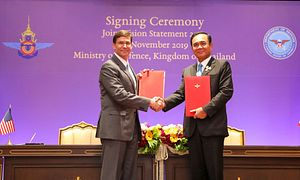This weekend, as expected, the United States and Thailand inked a new joint vision statement for their alliance relationship on the margins of the ASEAN Defense Ministers’ Meetings (ADMM) in Bangkok. The notable development highlighted the state of one of Washington’s five treaty alliances in the Asia-Pacific as well as how its future trajectory may shape up in the coming years.
The U.S.-Thailand alliance was initially forged as part of the 1954 Manila Pact of the now-defunct Southeast Asia Treaty Organization (SEATO), with the relationship subsequently reinforced by further steps and understandings including the Thanat-Rusk communique of 1962, Thailand’s elevation to the status of a major Non-NATO ally in 2003, and the 2012 Joint Vision Statement for the U.S.-Thailand Defense Alliance. The past few years have seen another phase of recalibration for the alliance, with an initial chill following the May 2014 coup and Bangkok’s growing ties with China gradually giving way to a thaw under the late Obama administration and the Trump administration, where there have been some subsequent gains as well.
One of the notable steps undertaken during the Trump administration is the inking of a new U.S.-Thailand joint vision statement. The joint vision statement has been worked on and discussed by both countries in previous meetings – as it was between then-Acting Defense Secretary Patrick Shanahan and then-Thai Defense Minister Prawit Wongsuwon on the margins of the Shangri-La Dialogue in Singapore in June – and indications were that the two sides would ink the agreement in November on the sidelines of the ADMM-Plus meetings in Bangkok.
This week, as expected, we saw the two countries ink the new joint vision statement. The signing of Joint Vision Statement 2020 occurred on November 17 at the Thai defense ministry between visiting U.S. Defense Secretary Mark Esper and Thai Prime Minister Prayut Chan-o-cha, who also holds the defense portfolio following elections held earlier this year.
While the development did not attract much in the way of headlines, it is not without significance. Like the 2012 joint vision statement released under the Obama administration, the 2020 joint vision statement it represents an ongoing effort to update and focus the alliance in line with the priorities and areas of focus for both sides in the contemporary context, in the wake of developments such as the shaping of the U.S. Free and Open Indo-Pacific vision and heightening doubts about ASEAN’s role within the regional architecture. And within the context of the evolution of U.S.-Thailand relations under the Trump administration, it represents another occasional gain for the alliance following a period of adjustment that occurred following the May 2014 coup.
In terms of its content, much like the publicly issued 2012 joint vision statement, the 2020 joint vision statement is short in length as it is meant to set out general areas of focus for defense collaboration updated within the current context. There are five points that are noted on collaboration in that respect: partnership; enduring presence; sustainable security cooperation; leadership; and regional security architecture. While some of the language on these points are quite similar to the ones set out in 2012 (which had four points on partnership; stability; interoperability; and relationship building, coordination, and collaboration), the current joint vision statement does highlight renewed points of emphasis for both sides that were not spelled out explicitly before, including the Indo-Pacific, the rules-based international order, ASEAN centrality, and sustainable security which has been a theme within ASEAN as well under Thailand’s chairmanship this year.
To be sure, as with any document of this ilk, there is a tendency to focus on areas of general agreement and opportunities rather than specific areas of difference or challenges that have emerged over the years, be it aspects of Thailand’s defense engagement with China or how Washington has been implementing aspects of its free and open Indo-Pacific Strategy relative to how Southeast Asian countries may think about the regional order and how it should be shaped. And as I have observed before as well, there are also broader questions for the alliance, such as how Thailand’s politics and its reading of the evolving U.S.-China strategic competition will affect the future trajectory of its defense policy. Given all that, how this joint vision statement plays out amid these realities as well as the ongoing developments in the alliance relationship will be a key area to watch in the coming months and years.
































